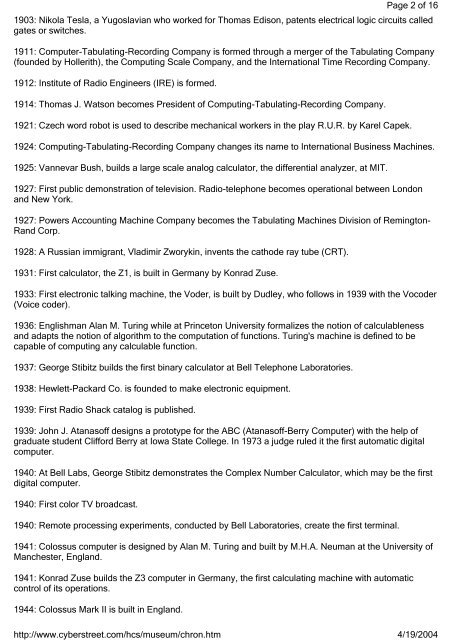A Chronology of Computer History: 3000 BC: Dust abacus is ...
A Chronology of Computer History: 3000 BC: Dust abacus is ...
A Chronology of Computer History: 3000 BC: Dust abacus is ...
Create successful ePaper yourself
Turn your PDF publications into a flip-book with our unique Google optimized e-Paper software.
1903: Nikola Tesla, a Yugoslavian who worked for Thomas Ed<strong>is</strong>on, patents electrical logic circuits called<br />
gates or switches.<br />
1911: <strong>Computer</strong>-Tabulating-Recording Company <strong>is</strong> formed through a merger <strong>of</strong> the Tabulating Company<br />
(founded by Hollerith), the Computing Scale Company, and the International Time Recording Company.<br />
1912: Institute <strong>of</strong> Radio Engineers (IRE) <strong>is</strong> formed.<br />
1914: Thomas J. Watson becomes President <strong>of</strong> Computing-Tabulating-Recording Company.<br />
1921: Czech word robot <strong>is</strong> used to describe mechanical workers in the play R.U.R. by Karel Capek.<br />
1924: Computing-Tabulating-Recording Company changes its name to International Business Machines.<br />
1925: Vannevar Bush, builds a large scale analog calculator, the differential analyzer, at MIT.<br />
1927: First public demonstration <strong>of</strong> telev<strong>is</strong>ion. Radio-telephone becomes operational between London<br />
and New York.<br />
1927: Powers Accounting Machine Company becomes the Tabulating Machines Div<strong>is</strong>ion <strong>of</strong> Remington-<br />
Rand Corp.<br />
1928: A Russian immigrant, Vladimir Zworykin, invents the cathode ray tube (CRT).<br />
1931: First calculator, the Z1, <strong>is</strong> built in Germany by Konrad Zuse.<br />
1933: First electronic talking machine, the Voder, <strong>is</strong> built by Dudley, who follows in 1939 with the Vocoder<br />
(Voice coder).<br />
1936: Engl<strong>is</strong>hman Alan M. Turing while at Princeton University formalizes the notion <strong>of</strong> calculableness<br />
and adapts the notion <strong>of</strong> algorithm to the computation <strong>of</strong> functions. Turing's machine <strong>is</strong> defined to be<br />
capable <strong>of</strong> computing any calculable function.<br />
1937: George Stibitz builds the first binary calculator at Bell Telephone Laboratories.<br />
1938: Hewlett-Packard Co. <strong>is</strong> founded to make electronic equipment.<br />
1939: First Radio Shack catalog <strong>is</strong> publ<strong>is</strong>hed.<br />
1939: John J. Atanas<strong>of</strong>f designs a prototype for the A<strong>BC</strong> (Atanas<strong>of</strong>f-Berry <strong>Computer</strong>) with the help <strong>of</strong><br />
graduate student Clifford Berry at Iowa State College. In 1973 a judge ruled it the first automatic digital<br />
computer.<br />
1940: At Bell Labs, George Stibitz demonstrates the Complex Number Calculator, which may be the first<br />
digital computer.<br />
1940: First color TV broadcast.<br />
1940: Remote processing experiments, conducted by Bell Laboratories, create the first terminal.<br />
1941: Colossus computer <strong>is</strong> designed by Alan M. Turing and built by M.H.A. Neuman at the University <strong>of</strong><br />
Manchester, England.<br />
1941: Konrad Zuse builds the Z3 computer in Germany, the first calculating machine with automatic<br />
control <strong>of</strong> its operations.<br />
1944: Colossus Mark II <strong>is</strong> built in England.<br />
http://www.cyberstreet.com/hcs/museum/chron.htm<br />
Page 2 <strong>of</strong> 16<br />
4/19/2004


